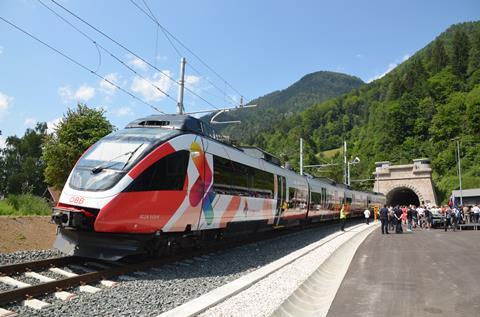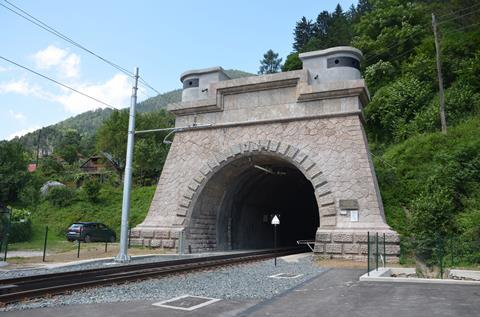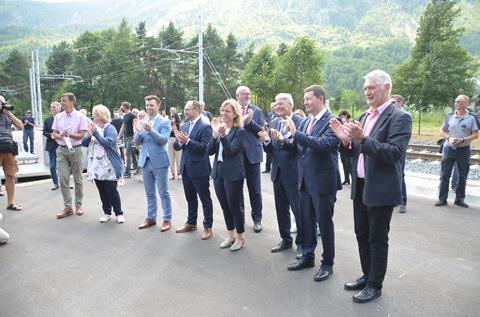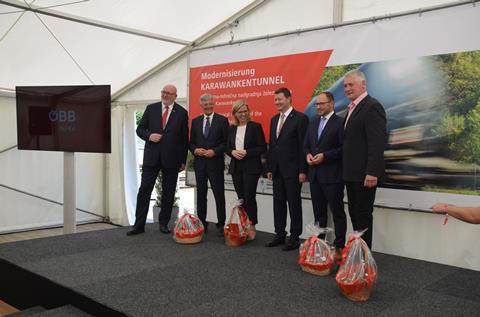
EUROPE: Cross-border rail services have resumed on the Villach – Ljubljana route between Austria and Slovenia, following the completion of a 10-month refurbishment of the Karawanken tunnel.

Dating from 1906, the 7 975 m bore had been closed to all traffic from September 7 2020 for full refurbishment and updating to meet current safety standards at a total cost of €140m. ÖBB contributed €73m, with the remainder coming from Slovenia with co-financing from the European Union. The main contractor for the work was Strabag.
An agreement for modernisation of the tunnel was signed between Austria and Slovenia in 2015, as part of an extensive upgrading of the Jesenice – Rosenbach line on which detailed engineering design began the following year. The former double-track line through the tunnel has been reduced to single track to facilitate the construction of a continuous escape route within the bore, along with the installation of fire protection and communications equipment. The maximum speed has been raised to 120 km/h.
Singling of the line through the tunnel is not expected to have a significant impact on capacity, as the remainder of the Villach – Ljubljana line is currently single track. Plans are being drawn up for construction of a second tunnel in conjunction with the proposed doubling of the entire route.

In conjunction with the tunnel modernisation, the contractors have renewed 12·3 km of the Jesenice – Rosenbach line, laying 26 000 m of new rail and more than 20 000 sleepers, along with 40 000 tonnes of ballast. The telecoms element included 31 km of optic fibre cables, 16 km of radio cable and the installation of two GSM-R base stations.
Ceremonies to mark the reopening were held at Rosenbach and Hrušica near Jesenice on July 29. ÖBB CEO Andreas Matthä explained that modernisation of the Karawanken tunnel was important for the passenger traffic on the München – Salzburg – Ljubljana – Thessaloniki axis, but also for enhancing freight connections between industrial centres in southern Germany, eastern Austria and the Adriatic ports.

‘More modern railway lines means more climate protection’, said Leonore Gewessler, Austria’s Federal Minister for Climate Protection, Environment, Energy, Mobility, Innovation & Technology. ‘Together we want to examine all the opportunities that climate-friendly transport brings. This is why we are building and renovating railway infrastructure throughout Austria.’
Her Slovenian counterpart, Jernej Vrtovec added that ensuring better railway links was a priority for the Ministry of Infrastructure, ‘because we can only achieve our ambitious environmental goals by concentrating on rail’. Reopening traffic through the renewed Karawanken tunnel was ‘a big step towards making traffic between the two countries more fluid and improving conditions for business and passengers’, he emphasised.
During the blockade of the tunnel, which required the diversion of all long-distance trains, Slovenske Železnice Infrastruktura took the opportunity to refurbish the Kranj – Jesenice line, replacing the remaining local trains by buses. This work was divided into three subprojects:
- Kranj – Podnart, 9·9 km, €48·9m;
- Podnart – Lesce Bled, 10·7 km, €46·9m;
- Lesce Bled – Jesenice, 12 km, €70·6m.
Although the line was reopened for international trains and freight services on July 30, buses are expected to continue replacing the Kranj – Jesenice stopping trains for a further month.

















